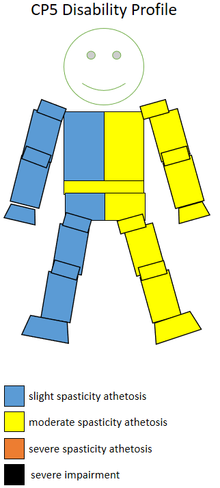C3 (classification)
C3 is a para-cycling classification. The class includes people with moderate upper or lower limb dysfunctions and includes cyclists with cerebral palsy, limb impairments and amputations. The UCI recommends this be coded as MC3 or WC3. The class competes at the Paralympic Games.
Definition
PBS defined this classification as "Cyclists with upper or lower limb disabilities and moderate neurological dysfunction."[1] The Telegraph defined this classification in 2011 as "C 1–5: Athletes with cerebral palsy, limb impairments and amputations."[2] The UCI recommends this be coded as MC3 or WC3.[3]
Disability groups


People with cerebral palsy are one of the groups covered by this classification, specifically the CP5 and CP6 classes. CP5 and CP6 competitors may compete using tricycles in the T2 class or they can choose to compete in the C3 class.[4][5]
CP5 sportspeople in this class have greater functional control of their upper body. They may require the use of an assistive device when walking but they do not require use of a wheelchair.[6][7][8] They often have problems with their dynamic equilibrium but not their static equilibrium.[9][10] Quick movements can upset their balance.[9][10]
CP6 sportspeople are able to walk without the need for an assistive device.[6] They lack coordination in all their limbs, with the greater lack of coordination involving their upper body.[6][11][12][8][10] Their bodies are often in motion, and they cannot maintain a still state.[12][10] While CP2, CP3 and CP6 have similar issues with Athetoid or Ataxic, CP6 competitors have "flight" while they are ambulant in that it is possible for both feet to not be touching the ground while walking. CP2 and CP3 are unable to do this.[13]
Classification history
Cycling first became a Paralympic sport at the 1988 Summer Paralympics.[14] In September 2006, governance for para-cycling passed from the International Paralympic Committee's International Cycling Committee to UCI at a meeting in Switzerland. When this happened, the responsibility of classifying the sport also changed.[15]
At the Paralympic Games
For the 2016 Summer Paralympics in Rio, the International Paralympic Committee had a zero classification at the Games policy. This policy was put into place in 2014, with the goal of avoiding last minute changes in classes that would negatively impact athlete training preparations. All competitors needed to be internationally classified with their classification status confirmed prior to the Games, with exceptions to this policy being dealt with on a case-by-case basis.[16]
Becoming classified
Classification is handled by Union Cycliste Internationale.[17] Classification for the UCI Para-Cycling World Championships is completed by at least two classification panels. Members of the classification panel must not have a relationship with the cyclist and must not be involved in the World Championships in any other role than as classifier.[18] In national competitions, the classification is handled by the national cycling federation.[18] Classification often has three components: physical, technical and observation assessment.[18]
Rankings
This classification has UCI rankings for elite competitors.[19]
Competitors
Competitors in this class include Australia's Simone Kennedy and Ireland's Eoghan Clifford.[20]
See also
References
- ^ "Competition at the Highest Levels, Cycling". Cycling. Retrieved 14 June 2012.
- ^ "London 2012 Paralympics: Road cycling guide". London: The Telegraph. 2011. Archived from the original on 28 August 2011. Retrieved 14 June 2012.
- ^ "UCI Para-cycling Classification Guide". UCI. 17 April 2012. p. 4.
- ^ "Classification Profiles" (PDF). Cerebral Palsy International Sports and Recreation Association. Archived from the original (PDF) on 18 August 2016. Retrieved 22 July 2016.
- ^ "Clasificaciones de Ciclismo" (PDF). Comisión Nacional de Cultura Física y Deporte (in Mexican Spanish). Mexico. Archived from the original (PDF) on 23 November 2012. Retrieved 23 July 2016.
- ^ a b c "CLASSIFICATION SYSTEM FOR STUDENTS WITH A DISABILITY". Queensland Sport. Archived from the original on 4 April 2015. Retrieved July 23, 2016.
- ^ "Classification Made Easy" (PDF). Sportability British Columbia. July 2011. Retrieved 23 July 2016.
- ^ a b "Kategorie postižení handicapovaných sportovců". Tyden (in Czech). 12 September 2008. Retrieved 23 July 2016.
- ^ a b "Clasificaciones de Ciclismo" (PDF). Comisión Nacional de Cultura Física y Deporte (in Mexican Spanish). Mexico. Archived from the original (PDF) on 23 November 2012. Retrieved 23 July 2016.
- ^ a b c d Cashman, Richmard; Darcy, Simon (1 January 2008). Benchmark Games. Benchmark Games. ISBN 9781876718053.
- ^ "Classification Profiles" (PDF). Cerebral Palsy International Sports and Recreation Association. Archived from the original (PDF) on 18 August 2016. Retrieved 22 July 2016.
- ^ a b "Clasificaciones de Ciclismo" (PDF). Comisión Nacional de Cultura Física y Deporte (in Mexican Spanish). Mexico. Archived from the original (PDF) on 23 November 2012. Retrieved 23 July 2016.
- ^ "Classification Rulebook" (PDF). International Federation of CP Football. January 2015. Retrieved 23 July 2016.
- ^ "Cycling". Australian Paralympic Committee. 2012. Archived from the original on 14 August 2016.
- ^ "Para-cycling High Performance". Australia: Cycling Australia. Archived from the original on 15 June 2012. Retrieved 14 June 2012.
- ^ "Rio 2016 Classification Guide" (PDF). International Paralympic Committee. March 2016. Retrieved 22 July 2016.
- ^ "Guide to the Paralympic Games – Appendix 1" (PDF). London Organising Committee of the Olympic and Paralympic Games. 2011. p. 42. Archived from the original (PDF) on 26 April 2012. Retrieved 9 April 2012.
- ^ a b c "UCI Para-cycling Classification Guide". UCI. 17 April 2012. p. 5.
- ^ "Ranking – PARA – Cycling 2012". Union Cycliste Internationale. June 2012. Archived from the original on 13 June 2012. Retrieved 14 June 2012.
- ^ "Simone Kennedy | APC Corporate". Paralympic.org.au. Retrieved 14 June 2012.

